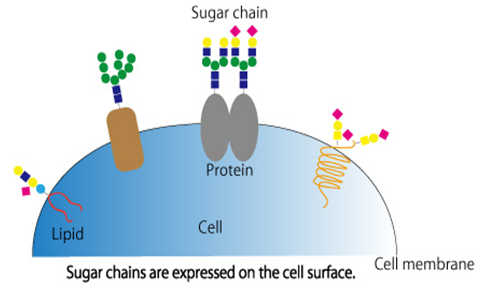Analysis Methods and Processes of Polysaccharides
Polysaccharides are polymers composed of more than 10 monosaccharide molecules linked by glycosidic bonds. They have relatively high molecular weights, usually consisting of hundreds or thousands of monosaccharide molecules. Along with nucleic acids, proteins, and lipids, polysaccharides are considered one of the four fundamental substances of life, playing significant roles in various biological activities. Known activities include immune regulation, anti-tumor effects, hypoglycemic and hypolipidemic effects, antiviral effects, elimination of oxidative free radicals, and delaying aging. Polysaccharides are widely distributed in the higher plants, animals, algae, and bacteria in nature. Most polysaccharides originate from tissue cells and have low toxicity, making them an ideal source for pharmaceuticals. In recent years, with the rapid development of related fields such as biology and chemistry, the research on polysaccharide compounds has gained increasing attention. The international scientific community views polysaccharide research as a frontier field in life sciences, with some even proposing that the 21st century is the century of polysaccharides.

Methods and Processes of Polysaccharide Analysis
Methods and Processes for Polysaccharide Analysis
1. Extraction of Polysaccharides:Polysaccharides are connected to cell walls or interstitial substances through hydrogen or ionic bonds. Different extraction methods are used depending on the location of the polysaccharide. Common solvents include hot water, acids, bases, and ethanol, with microwave or ultrasonic assistance for crude extraction. Common methods include supercritical fluid extraction and complex enzyme-assisted extraction techniques. These methods allow complex enzymes to specifically degrade the barriers of cell walls and intracellular macromolecules under mild conditions, thus accelerating the release of polysaccharides. The reaction can be controlled by altering system conditions according to the characteristics of the enzymes.
2. Removal of Polysaccharide Impurities:Crude polysaccharide extracts often contain impurities such as inorganic salts, lipids, proteins, and low molecular non-polar substances. Low molecular weight impurities can be removed using dialysis. Proteins can be removed using protease methods, Sevag method, TCA method, and trifluorochloroethane method. Lipids can be removed using organic solvents like ethanol, diethyl ether, and petroleum ether. Common methods for removing pigment impurities include adsorption and oxidation.
3. Separation and Purification of Polysaccharides:After separating and removing impurities, a mixed polysaccharide solution is obtained. The process of separating this solution into various individual polysaccharides is called purification. More commonly used purification methods include precipitation, chromatography, zone electrophoresis, ultracentrifugation, and other biochemical analysis techniques. Typically, polysaccharide purification requires combining two or more methods to optimize the results.
Polysaccharide Analysis Includes:Due to the diverse composition, complex structure, and large molecular weight of polysaccharides, analysis is usually conducted from the following four aspects:
1. Determination of Sugar Content:The determination of sugar content in samples is often performed using the chromogenic agent-sulfuric acid method. Monosaccharides, polysaccharides, and their derivatives hydrolyze into monosaccharides under the action of sulfuric acid, rapidly dehydrating to form aldehyde derivatives, which then condense with phenols and aromatic amines into colored compounds. Polysaccharide content is indirectly determined by colorimetric quantification. These methods are simple, fast, and sensitive, with good color stability for the colored compounds.
2. Determination of Molecular Weight:There is no absolute method for determining the molecular weight of polysaccharides, so statistical average methods are usually used. Previously, methods such as osmotic pressure, end-group, viscosity, and light scattering methods were used, but they are complex to operate and prone to error. Currently, more commonly used methods are gel filtration and high-performance liquid chromatography. Both methods require using standard polysaccharides with known molecular weights as controls. For polysaccharides with molecular weights less than 50,000, mass spectrometry can be used.
3. Component Analysis:Polysaccharide component analysis methods can generally be divided into traditional chemical analysis, physical analysis (instrumental analysis), and biological analysis. Chemical analysis includes partial or complete acid hydrolysis, neutralization, and filtration. Finally, analysis is conducted using paper chromatography (PC), thin-layer chromatography (TLC), gas chromatography (GC), liquid chromatography (HPLC), or ion chromatography. Widely used instrumental analysis methods include spectrophotometry, infrared spectroscopy, nuclear magnetic resonance, gas chromatography, and mass spectrometry.
4. Structure Identification:Polysaccharides have more complex macromolecular structures than proteins. The diversity of monosaccharides, the connectivity, and the complexity of branching make structure identification challenging. Currently, the main goal of structure identification is to analyze the molecular weight range, monosaccharide types, proportions and connectivity sequences, and the configuration of glycosidic bonds. Common structural analysis methods include periodate oxidation, Smith degradation, and methylation reaction. In recent years, the use of advanced instruments has greatly improved the analysis methods.
Related Services
Glycomics Analysis Services
Glycolipid Polysaccharide Analysis
HILIC-UHPLC Analysis of N-glycosidic Bonds
Carbohydrates and Carbohydrate Metabolism
Targeted Metabolomics
How to order?





